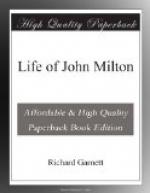It is something in favour of the Milton girls that they were at least not calculating in their undutifulness. Had they reflected, they must have seen that their behaviour was little to their interest. If they brought a stepmother upon themselves, the blame was theirs. Something must certainly be done to keep Milton’s library from the rag-women; and in February, 1663, by the advice of his excellent physician Dr. Paget, he married Elizabeth Minshull, daughter of a yeoman of Wistaston in Cheshire, a distant relation of Dr. Paget’s own, and exactly thirty years younger than Milton. “A genteel person, a peaceful and agreeable woman,” says Aubrey, who knew her, and refutes by anticipation Richardson’s anonymous informant, perhaps Deborah Clarke, who libelled her as “a termagant.” She was pretty, and had golden hair, which one connects pleasantly with the late sunshine she brought into Milton’s life. She sang to his accompaniment on the organ and bass-viol, but is not recorded to have read or written for him; the only direct testimony we have of her care of him is his verbal acknowledgment of her attention to his creature comforts. Yet Aubrey’s memoranda show that she could talk with her husband about Hobbes, and she treasured the letters he had received from distinguished foreigners. At the time of their marriage Milton was living in Jewin Street, Aldersgate, from which he soon afterwards removed to Artillery Walk, Bunhill Fields, his last residence. He lodged in the interim with Millington, the book auctioneer, a man of superior ability, whom an informant of Richardson’s had often met in the streets leading his inmate by the hand.
It is at this era of Milton’s history that we obtain the fullest details of his daily life, as being nearer to the recollection of those from whom information was sought after his death. His household was larger than might have been expected in his reduced circumstances; he had a man-servant, Greene, and a maid, named Fisher. That true hero-worshipper, Aubrey, tells us that he generally rose at four, and




